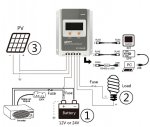That's not how any of the ones I've seen are meant to work. The load circuit is simply a software-controlled output. The power from the load terminals comes from the
battery, not from the panel.
You can choose to have the load switch on when the sun stops shining (for a street light, for example) or to come on when the sun is shining (for a cooling fan, for example). You can have it set to switch the load off if the
battery voltage falls below a set amount, such as 11.2v, to protect it from over-discharge.
I can't see how you could set it to switch on when the
battery was fully charged, becasue as soon as it went on, the
battery would no longer be fully charged.
If your controller could power the load from the panel, not the
battery, it would be the first I've heard of with this ability, and I'm not sure it would be sensible. The voltage would be rather unpredictable.
"The load circuit is simply a software-controlled output."
Exactly, the charge controller switches from charging the
battery to directing the current TO the load terminals, it works in a similar way to a split-charge relay.
"The power from the load terminals comes from the
battery, not from the panel."
You directly contradict yourself in one sentence - the LOAD terminals are an OUTPUT - which outputs the
solar voltage to an alternative load.
Click on the picture that I provided - its clearly shows what the LOAD terminals do.
The rest of your post is based upon incorrect understanding of what the load terminals actually do.
In your scenario, the lights and appliances would all go out when the controller sensed that the batteries needed a charge.
In all mobile installations that I have seen, the vehicle electrical devices (lights, fans, 12v sockets etc) are all supplied by a 12v
fuse board.
The
fuse board is connected directly to the leisure batteries.
The leisure batteries can have multiple charging methods,
a) from the engine alternator,
b) from a genny
c) from a
solar panel(s)
or whatever.
Its not unusual for a motorhome to have multiple charging methods, connected simultaneously. eg the engine running and a
solar panel, both delivering charging current as needed and both having a capability to reduce and then cut off the charging current, depending upon the charge state.
The
solar charge controller offers an alternative pair of terminals that can be used to feed non essential loads such as a water heater, another
battery, in the case of a water heater, this
solar power is no good as the only source of current, it is meant to pre-heat the tank as a supplement to the usual heating method (on a van its usually LPG).
Solar charging goes directly from the charge controller to the leisure batteries.
When the batteries are fully charged, the
solar panels output is then available for other uses, the original question suggests that it is used to heat water, although I am still unclear as to how it is wired up. The present wiring configuration seems to be a flawed design
Peace
James

